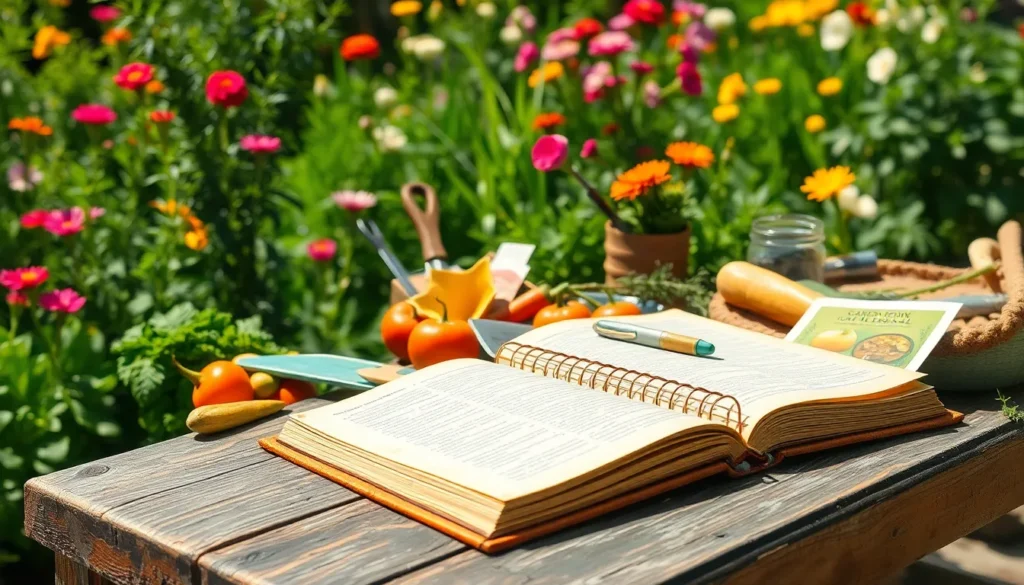Gardening transforms from a simple hobby into a rewarding journey when we start documenting our experiences. Garden journals capture the magic of watching seeds become thriving plants while helping us learn from both our successes and mistakes.
We’ve discovered that keeping detailed records isn’t just about tracking what we plant and when. It’s about creating a personalized guide that grows with our gardening knowledge. From sketching garden layouts to recording weather patterns and noting which varieties perform best in our unique conditions, these journals become invaluable references year after year.
Whether you’re a beginner eager to remember which flowers bloomed when or an experienced gardener wanting to optimize your harvest timing, we’ll share creative and practical garden journal ideas that’ll revolutionize how you approach your outdoor space. Let’s explore the tools and techniques that’ll turn your gardening observations into actionable insights for seasons to come.
Track Your Seasonal Planting Schedule
Seasonal planning transforms chaotic gardening into organized success. We’ll show you how documenting your planting timeline creates a roadmap for year-round productivity.
Spring Planting Calendar
Create dedicated pages for each spring month to capture the rush of early season activity. Document your last frost date alongside soil temperature readings and moisture levels. Record which seeds you start indoors versus direct sowing outdoors. Track germination rates for tomatoes peppers and herbs to improve next year’s timing.
Map out your succession planting schedule by noting 2-week intervals for crops like lettuce spinach and radishes. Include companion planting combinations that worked well together. Note weather patterns that affected your planting decisions and soil preparation dates.
Monitor your seedling progress with weekly photos and growth measurements. Record transplant dates and success rates for different varieties. Track which plants thrived in exact garden locations and microclimates.
Summer Succession Planting
Schedule continuous harvests by planning 10-14 day intervals for quick growing crops. Document your bean plantings every two weeks and corn plantings every three weeks. Record which varieties performed best in summer heat and humidity.
Track your watering schedule alongside planting dates to identify drought resistant varieties. Note which plants required extra irrigation during peak summer months. Document mulching applications and their effectiveness in retaining soil moisture.
Plan for heat tolerant varieties by researching and testing new cultivars each season. Record which summer squash and cucumber varieties produced consistently through hot weather. Track pest pressure changes throughout the growing season.
Fall Harvest Planning
Calculate backwards from your first frost date to determine final planting windows for cool season crops. Document optimal timing for winter squash harvest based on stem condition and skin hardness. Record storage preparation methods that extended your harvest season.
Track preservation activities by noting which crops you canned frozen or dehydrated. Document successful preservation quantities and methods for future planning. Record which varieties stored longest in root cellars or cold frames.
Monitor fall planting success for garlic shallots and overwintering onions. Track which cover crops you planted and their spring performance. Document soil amendments added during fall garden cleanup.
Winter Garden Preparation
Document your season ending cleanup tasks including compost pile management and tool maintenance schedules. Record which perennial plants you divided or relocated. Track mulching applications around trees shrubs and perennial beds.
Plan next year’s garden layout using your seasonal data to optimize crop rotations. Document which garden beds need soil amendments or structural improvements. Record seed saving activities and storage methods for collected seeds.
Review your entire year’s data to identify patterns in plant performance and weather impacts. Track successful experiments and note failures for future reference. Document garden infrastructure projects completed and planned for the following year.
Record Plant Growth and Development

Detailed plant observations form the foundation of successful gardening practices. We can transform our gardening skills by maintaining comprehensive records that track each plant’s journey from seed to maturity.
Seedling Growth Charts
Graph paper becomes our best friend when tracking seedling development over time. We recommend measuring stem height and counting leaves at regular intervals, whether daily or weekly depending on your schedule. Visual charts help us identify growth patterns and spot potential issues before they become serious problems.
Recording environmental conditions alongside growth measurements provides valuable insights into what makes our plants thrive. We should note light exposure, temperature fluctuations, and watering schedules to correlate with our growth results. Small delays or unusual patterns become obvious when we maintain consistent documentation.
Template creation saves time and ensures we capture the same data points for every seedling. We can design our own charts or use printed templates that include spaces for plant variety, germination date, and weekly measurements.
Flowering and Fruiting Timelines
Calendar tracking transforms how we understand our plants’ natural rhythms. We benefit from noting exactly when each plant begins to flower and when fruits start developing. This information helps us optimize future planting schedules and manage our expectations throughout the growing season.
Phenology documentation reveals patterns that aren’t immediately obvious during busy gardening seasons. We should record the length of flowering periods and fruiting phases for each plant species or variety. Different cultivars of the same plant often have varying timelines that affect our harvest planning.
Seasonal variations become clear when we compare timelines across multiple years. We can identify which varieties perform consistently and which ones are affected by weather changes or other environmental factors.
Height and Spread Measurements
Regular measurement sessions provide concrete data about our plants’ physical development. We should record both height and width measurements with corresponding dates to track how plants expand throughout the growing season. This data proves invaluable for planning garden spacing and companion planting arrangements.
Growth rate calculations help us predict when plants will reach maturity or when they might outgrow their designated spaces. We can adjust our care routines based on whether plants are growing faster or slower than expected. Weekly measurements work well for most plants, though rapidly growing species might benefit from more frequent tracking.
Spacing optimization becomes easier when we have historical data about mature plant sizes. We can use our measurements to plan better garden layouts and avoid overcrowding issues that reduce plant health and productivity.
Document Weather Patterns and Their Impact
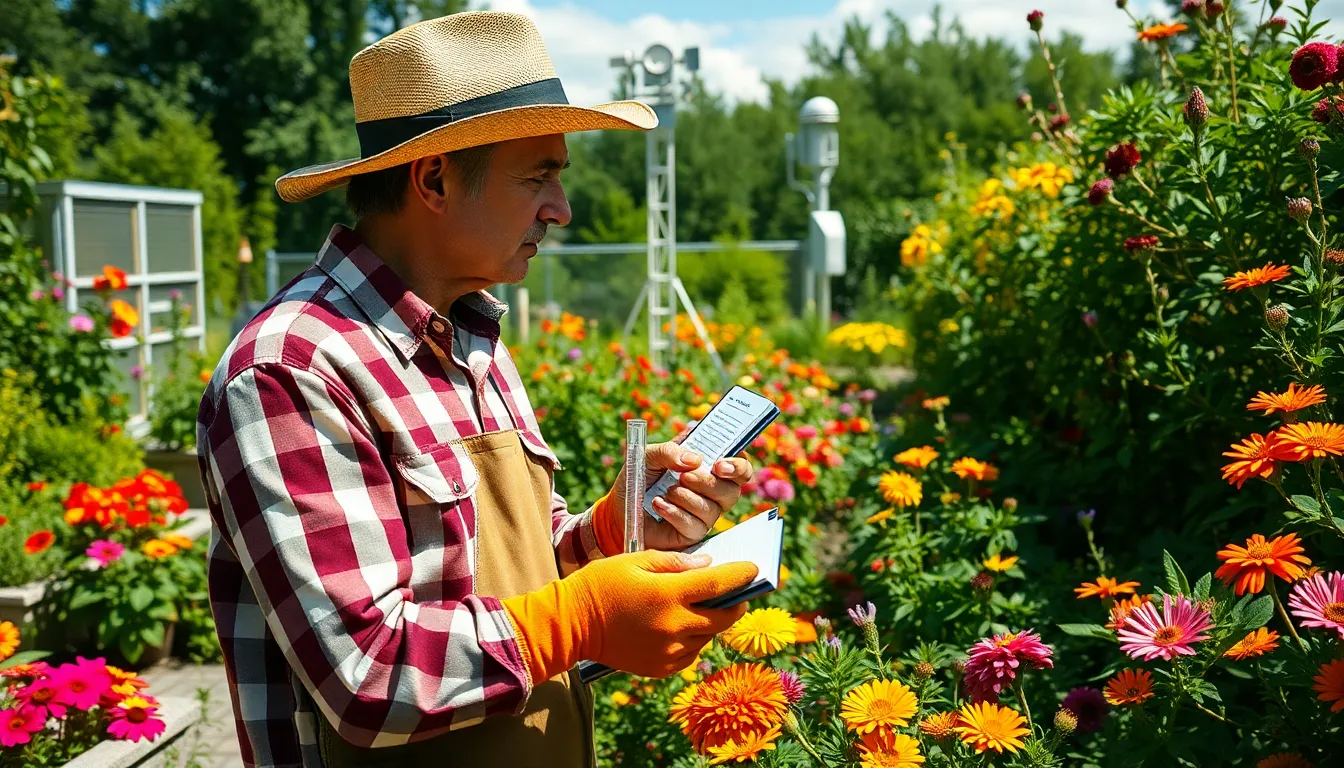
Weather documentation transforms our gardening journals into powerful predictive tools. Recording environmental conditions helps us understand the direct relationship between climate patterns and plant performance.
Daily Temperature Logs
Temperature tracking provides essential data for understanding how heat and cold exposure affects our plants throughout the growing season. We can create simple charts that record morning, afternoon, and evening temperatures alongside our plant observations. Noting temperature fluctuations helps us identify stress patterns in different varieties and understand why certain plants thrive while others struggle.
Digital tools like Garden Time offer real-time weather integration that automatically logs temperature data with customizable templates. We can supplement automated tracking with manual observations about how our plants respond to exact temperature ranges. Recording both air temperature and soil temperature creates a complete picture of the growing environment our plants experience daily.
Rainfall Tracking
Rainfall documentation reveals how precipitation directly impacts soil moisture, plant health, and nutrient availability in our gardens. We should record not just the amount of rainfall but also the intensity and duration of each precipitation event. Light, steady rains affect plants differently than heavy downpours that may cause runoff or soil erosion.
Tracking dry spells alongside rainfall data helps us adapt our watering schedules and mulch application strategies effectively. We can observe which plants show stress first during drought conditions and which varieties remain resilient. Monthly rainfall totals compared to plant performance data reveal patterns that guide our irrigation planning and plant selection decisions.
Frost Date Records
Frost date documentation protects our gardens from temperature extremes that can damage sensitive plants and disrupt growing seasons. We need to record both the last spring frost and first fall frost dates each year to establish our local frost patterns. Late or early frosts can significantly impact planting and harvest cycles, making this data critical for future planning.
Recording frost severity levels helps us understand which plants can survive light frosts versus hard freezes. We should note microclimate variations within our gardens, as some areas may experience frost while others remain protected. This detailed frost tracking enables us to make informed decisions about plant protection strategies and variety selection.
Seasonal Weather Trends
Seasonal pattern analysis reveals long term climate shifts that influence our gardening strategies and plant choices. We can identify prolonged dry spells, unusually wet seasons, or temperature anomalies by comparing data across multiple years. Weather trends including humidity levels, day length changes, and storm frequency all affect plant growth and pest management decisions.
Documenting microclimate variations within our gardens supports better plant placement and care strategies. We might notice that certain areas stay cooler or retain moisture longer than others, information that proves invaluable for optimizing plant performance. Consistent weather data collection builds a comprehensive resource that improves our future garden planning and helps us adapt to changing environmental conditions.
Monitor Pest and Disease Issues
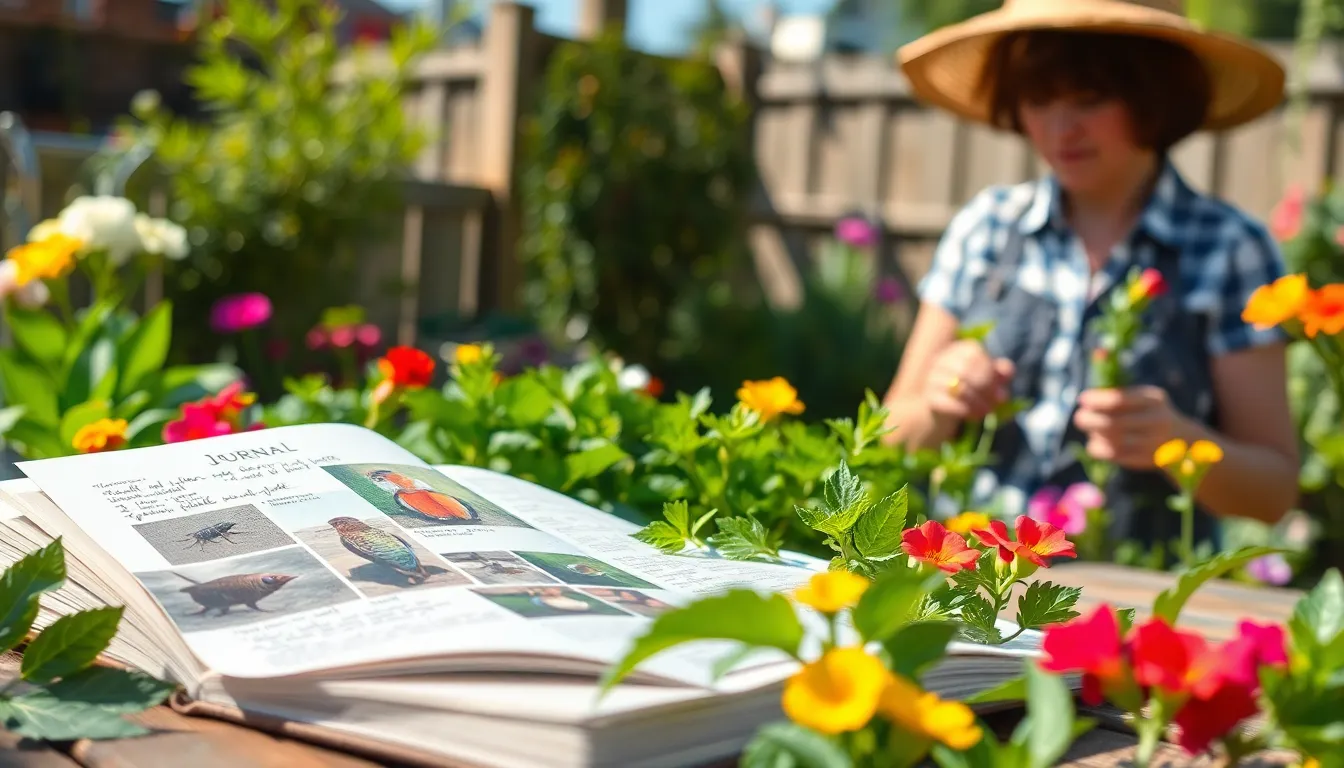
Recording pest and disease encounters creates a valuable defense system for our gardens. This documentation helps us identify patterns and develop effective management strategies over time.
Pest Identification Photos
Capturing clear images of pests and disease symptoms transforms our journals into visual identification guides. We should photograph both the pest itself and any damage it causes to plant leaves, stems, or fruits. Taking multiple angles helps us identify insects accurately using field guides or online databases later.
Close-up shots using a hand lens reveal details of small insects or mites that might otherwise go unnoticed. We can document the date, plant variety affected, and exact symptoms alongside each photo. This visual record becomes invaluable when consulting with extension agents or experienced gardeners about treatment options.
Treatment Methods and Results
Documenting every treatment we apply creates a comprehensive record of what works in our exact garden conditions. We should record the exact products used, application rates, and timing of treatments for both chemical and organic answers. This includes cultural practices like pruning infected branches or adjusting irrigation schedules.
Tracking treatment effectiveness helps us build a personalized pest management toolkit. We can note whether treatments eliminated the problem completely, reduced damage, or failed to provide control. Recording whether we’d use the same method again saves time and resources in future growing seasons.
Prevention Strategies That Work
Implementing and documenting prevention methods reduces the need for reactive treatments. Cultural practices like proper plant spacing, crop rotation, and pruning for air circulation prevent many pest and disease issues before they start. We should record which prevention strategies consistently protect our plants.
Biological controls offer sustainable pest management options worth tracking in our journals. Introducing beneficial insects like ladybugs or lacewings, or encouraging natural predators through habitat creation, provides long-term pest control. Integrated pest management combines physical barriers, cultural practices, biological controls, and targeted chemical treatments to minimize environmental impact while maintaining plant health.
Create Detailed Plant Profiles
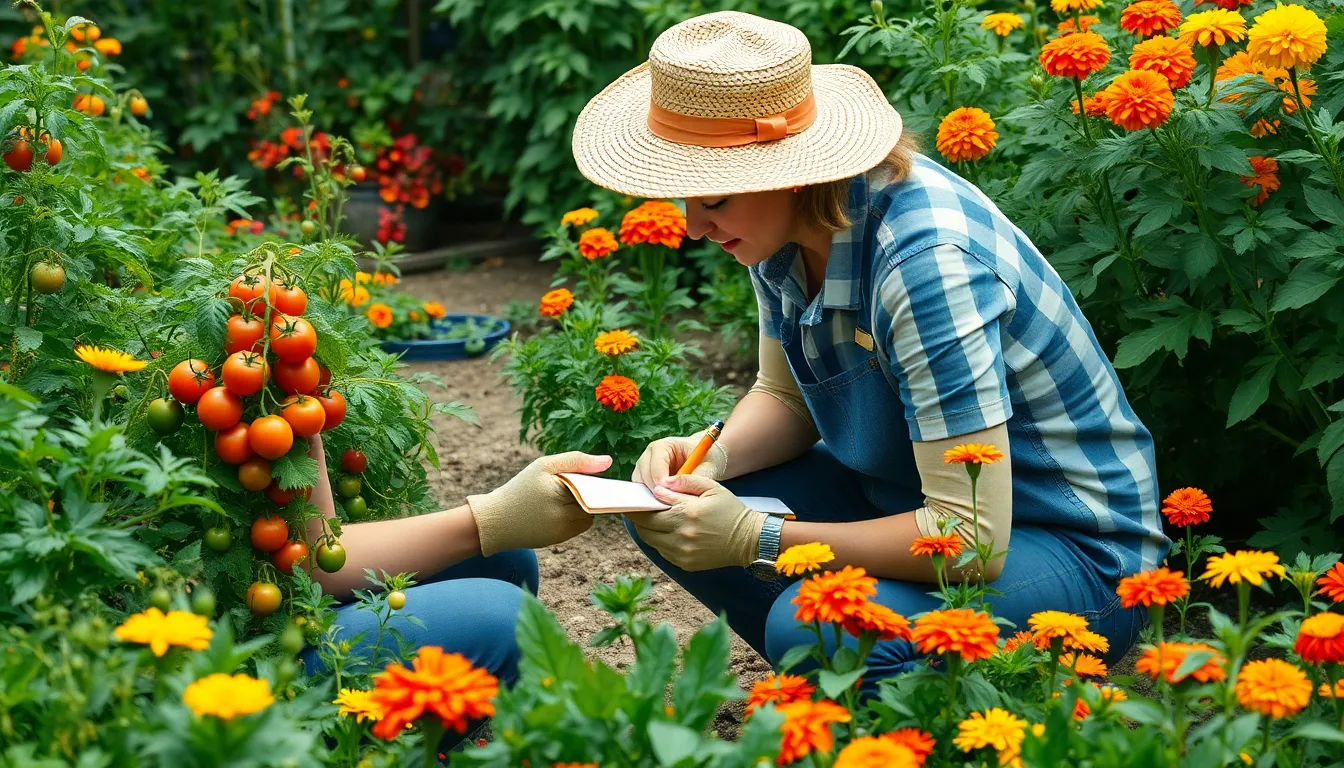
Building comprehensive plant profiles transforms our garden journals into powerful reference guides. We’ll create detailed documentation that captures each plant’s unique characteristics and performance patterns.
Variety Performance Notes
Document yield data systematically to make informed decisions about future plantings. We record harvest dates and quantities for vegetables, noting which tomato varieties produce the most fruit or when our lettuce begins to bolt. Track pest resistance by observing which cucumber varieties show fewer signs of bacterial wilt or powdery mildew throughout the growing season.
Monitor disease vulnerabilities across different plant varieties to identify the strongest performers. We note when certain rose varieties develop black spot while others remain healthy, or document which bean varieties resist mosaic virus. Overall vigor assessments help us compare plant health, with notes about leaf color, growth rate, and recovery from stress conditions.
Summarize performance observations at season’s end to guide next year’s variety selections. We create simple ratings for each variety based on productivity, disease resistance, and maintenance requirements. This systematic approach ensures we choose varieties best adapted to our exact garden environment and growing conditions.
Companion Planting Observations
Record which plants thrive together by documenting successful combinations and their exact benefits. We note when marigolds planted near tomatoes show reduced aphid pressure, or observe how basil growing alongside peppers enhances both plants’ growth. Document any increases in pollinator activity when we plant zinnias near vegetable crops.
Track pest reduction benefits from strategic plant pairings to optimize natural pest control. We observe whether nasturtiums truly attract aphids away from our cucumber plants, or monitor if planting garlic between roses reduces pest damage. Note companion plants that seem to repel exact insects or attract beneficial predators.
Monitor enhanced growth patterns when certain plants grow in proximity to each other. We document if corn, beans, and squash in our Three Sisters garden show better overall performance than when grown separately. Record any changes in yield, plant size, or fruiting patterns that correlate with exact companion planting arrangements.
Soil Preference Documentation
Document soil conditions thoroughly for each garden area to match plants with optimal growing environments. We record soil type, pH readings, and moisture levels using simple test kits or observations about drainage after rainfall. Note amendments we’ve added, such as compost quantities, lime applications, or organic matter incorporation dates.
Track plant performance in different soil conditions to refine our planting strategies. We observe which vegetables thrive in our clay soil versus sandy areas, or note how certain perennials perform better in acidic versus neutral pH zones. Document any correlation between soil moisture levels and plant health or productivity.
Refine soil management strategies based on our documented observations and plant responses. We adjust our amendment schedule based on which areas show the best plant performance, or modify watering patterns according to soil drainage characteristics. This targeted approach helps us create optimal growing conditions for exact plant preferences throughout our garden.
Track Harvest Yields and Quality
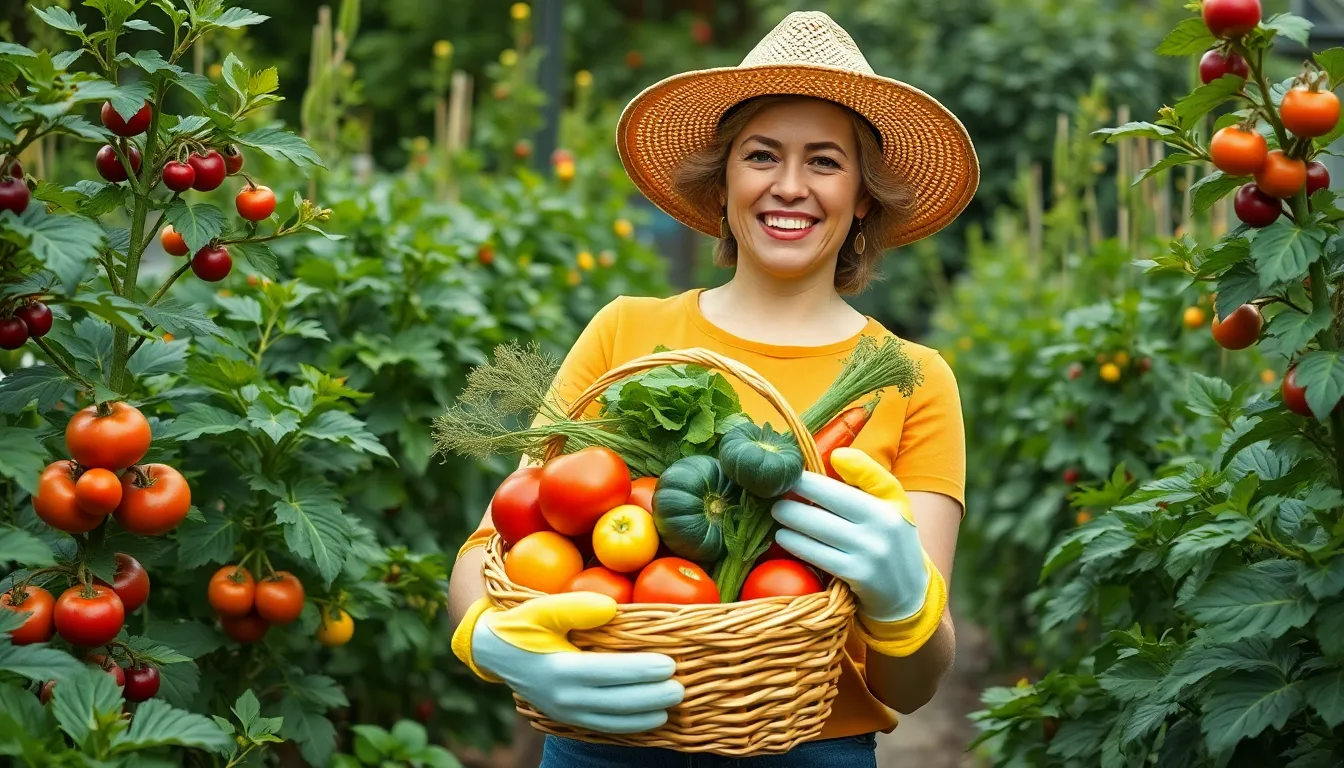
Building on our systematic approach to garden documentation, we’ll now focus on maximizing the value of our harvest through detailed tracking and practical applications.
Weekly Harvest Records
Creating consistent weekly harvest logs transforms scattered garden visits into strategic data collection. We recommend recording the exact quantities harvested from each plant or bed, along with exact dates and observable quality indicators like taste, texture, and visual appearance. This systematic approach helps us identify peak production periods and seasonal variations that influence crop performance.
Documenting harvest progression week by week reveals valuable patterns about plant productivity and timing. We can track which varieties produce consistently versus those that deliver concentrated harvests, enabling better succession planting decisions. Recording these details also helps us calculate expected yields for meal planning and preservation scheduling.
Quality assessments during weekly harvests provide insights into optimal picking times and storage requirements. We should note factors like fruit firmness, leaf tenderness, and flavor intensity to determine the best harvest windows for different intended uses. These observations guide future planting schedules and help us maximize both quantity and quality from our garden efforts.
Storage and Preservation Notes
Effective storage documentation begins with recording the exact methods we use for each type of produce, including freezing techniques, canning processes, drying methods, and fermentation approaches. We should track how long different vegetables maintain their quality under various storage conditions, noting which methods work best for exact varieties and harvest stages.
Preservation outcome tracking helps us refine our techniques and reduce food waste significantly. We recommend documenting storage duration, quality retention rates, and any modifications that improve results. This data becomes invaluable for planning future preservation activities and determining optimal harvest quantities.
Temperature and humidity conditions during storage greatly impact produce longevity and quality. We should record environmental factors alongside our preservation methods, creating a comprehensive reference for replicating successful storage outcomes. These notes help us identify which storage locations and techniques deliver the best results for different crops.
Recipe Ideas and Cooking Tips
Garden to table connections strengthen when we document recipes that showcase our fresh produce effectively. We recommend recording successful recipe modifications that highlight the unique flavors and textures of homegrown ingredients, noting which cooking methods enhance or diminish the quality of our harvest.
Seasonal recipe planning becomes more strategic when we track which dishes work best with exact harvest periods. We should document cooking techniques that maximize flavor from peak season produce, including optimal preparation methods for different stages of ripeness. This approach helps us use our garden bounty most effectively throughout the growing season.
Ingredient substitution notes prove valuable when garden yields vary from expected quantities. We can record successful replacements using our available produce, creating flexible recipes that adapt to our actual harvest rather than predetermined shopping lists. These adaptations often lead to discovering new favorite combinations that highlight our garden’s unique productivity patterns.
Plan Future Garden Improvements

Future improvements transform our gardening dreams into actionable plans that enhance both productivity and beauty. Strategic planning through journaling ensures we’re building toward a more efficient and rewarding garden experience.
Layout Sketches and Modifications
Sketching our garden layout directly in our journal creates a visual roadmap for ongoing improvements. We can draw detailed diagrams of garden beds, pathways, and plant placements to visualize space utilization and plant relationships effectively. Color coding different areas helps us represent plant types, soil treatments, or seasonal rotations at a peek.
Over time, these sketches become invaluable records of modifications we’ve made. We document relocated plants, expanded beds, or reconfigured pathways to track what works best in our exact space. Plant labels and seed packets stored alongside these sketches provide quick reference points for future planning decisions.
Digital journaling options allow us to include photos of our layouts for year-over-year visual comparisons. We can capture the evolution of our garden spaces and identify successful design elements worth replicating in other areas.
New Varieties to Try Next Season
Documenting new plant varieties we want to experiment with keeps our gardening fresh and exciting. We attach seed packets or photograph plant tags directly in our journal to maintain all cultural requirements and variety information in one convenient location. This method ensures we don’t lose track of promising varieties we’ve discovered throughout the season.
Recording observations about new varieties’ performance helps us make informed decisions for future plantings. We note flowering times, disease resistance, and overall productivity to build our own variety database. Trusted seed sources and varietal reviews from gardening communities deserve dedicated space in our planning notes.
Performance comparisons between new and established varieties provide concrete data for our garden evolution. We track which experiments succeeded and which ones we won’t repeat, creating a personalized guide for continuous improvement.
Infrastructure Upgrades Needed
Our journal becomes a comprehensive maintenance tracker for existing garden infrastructure. We document the condition of trellises, irrigation systems, raised beds, and fencing to identify repair needs before they become major problems. Running lists of infrastructure tasks ensure nothing gets overlooked during busy growing seasons.
Planning and sketching proposed improvements helps us visualize upgrades before implementation. We track required materials, cost estimates, and installation schedules to budget effectively for major projects. Before and after photos illustrate the impact of our improvements and guide future upgrade decisions.
Maintenance schedules for seasonal infrastructure tasks keep our garden running smoothly year after year. We note when to clean irrigation lines, repair fencing, or replace worn tools to maintain peak garden functionality.
Include Garden Photography

Garden photography transforms our written observations into powerful visual documentation that captures details our words might miss. These images become invaluable references that enhance our understanding of plant behavior and garden evolution.
Before and After Comparisons
Garden transformation photography provides compelling evidence of our gardening progress over time. We recommend taking baseline photos of new garden beds or renovation projects to establish a visual starting point. Document the initial soil conditions, existing vegetation, and overall layout before making any changes.
Monthly comparison shots from the same angle help us track dramatic transformations throughout growing seasons. Position ourselves in identical spots and use consistent lighting when possible to maintain photo accuracy. These comparative images reveal subtle changes that daily observation might overlook.
Seasonal transformation records showcase how our gardens evolve from dormant winter landscapes to lush summer displays. We can identify which areas develop most successfully and which zones need additional attention. Documentation helps us understand growth patterns and plan future improvements based on visual evidence.
Seasonal Progress Photos
Spring emergence photography captures the exciting moment when plants begin their annual growth cycle. We should document bulb emergence dates, tree budding progress, and perennial shoots breaking through soil. These images help us track seasonal timing variations from year to year.
Summer peak performance shots record our gardens at their most productive and beautiful stages. Document flowering sequences, fruit development, and overall plant health during optimal growing conditions. We can use these images to identify our most successful varieties and plan future plantings accordingly.
Fall transition documentation shows how our gardens prepare for dormancy and reveals autumn color progressions. Photograph seed head development, foliage changes, and harvest preparations to track seasonal patterns. These images help us understand natural cycles and plan winter garden maintenance.
Winter structure photography reveals the backbone of our garden design when foliage disappears. Document evergreen plants, hardscape elements, and bare branch patterns to evaluate our garden’s year round appeal. We can identify areas that need additional winter interest plants or structural improvements.
Problem Documentation Images
Pest identification photography creates a visual reference library for future problem solving efforts. We should capture clear images of insects, eggs, larvae, and damage patterns to build our diagnostic skills. Include ruler measurements or common objects for size reference when photographing small pests.
Disease symptom documentation helps us track plant health issues and monitor treatment effectiveness over time. Photograph affected leaves, stems, roots, and overall plant decline to understand disease progression patterns. We can compare symptoms across different varieties and growing conditions.
Environmental stress photography records how weather extremes and growing conditions affect our plants. Document drought damage, frost injury, wind damage, and soil problems to understand environmental impacts. These images help us identify vulnerable areas and develop protective strategies for future seasons.
Treatment progress documentation shows how our intervention methods perform over time. Photograph problem areas before treatment, during application, and at regular intervals afterward to evaluate solution effectiveness. We can refine our approach based on visual evidence of what works best in our exact garden conditions.
Maintain Expense and Budget Tracking
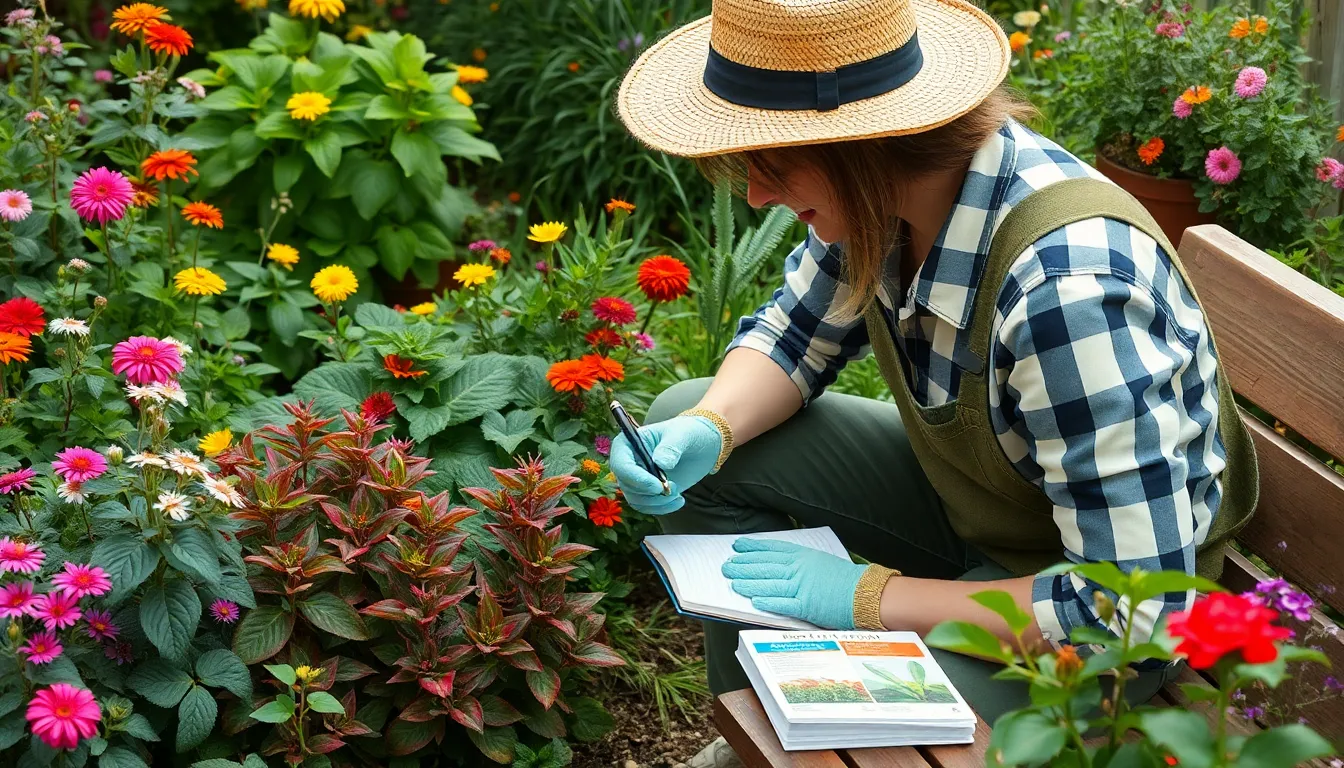
Effective garden journaling extends beyond plant care to include comprehensive financial tracking that helps maximize our gardening investment. Printable garden budget planners serve as powerful tools for monitoring expenses and maintaining spending control throughout the growing season.
Seed and Plant Purchase Records
Seed purchases require detailed documentation to track our garden’s financial foundation. We should record the purchase date, variety name, quantity purchased, and total cost for each seed packet or plant. Creating a dedicated log helps us identify which suppliers offer the best value and quality for our exact growing conditions.
Plant variety information becomes invaluable when we document the source of each purchase alongside performance notes. Recording whether seeds came from local nurseries, online retailers, or seed swaps allows us to evaluate supplier reliability over multiple seasons. We can also track germination rates and plant survival to determine which sources provide the most viable seeds.
Purchase timing affects both cost and plant success, making it essential to note when we buy seeds and plants. Early season purchases often come with discounts, while late season buying might limit variety availability. Documenting these patterns helps us plan future purchases more strategically and budget accordingly.
Tool and Supply Investments
Tool expenditures represent important garden investments that deserve careful tracking by type, quantity, and cost. We should document each purchase with its intended use, expected lifespan, and actual performance over time. This data helps us identify which tools provide the best value and durability for our exact gardening needs.
Supply purchases including fertilizers, soil amendments, and pest control products require systematic recording to optimize our garden budget. Tracking quantities used per season alongside their effectiveness helps us calculate accurate supply needs for future years. We can also monitor price fluctuations to time our bulk purchases during sales periods.
Maintenance schedules for tools and equipment prevent costly replacements and ensure optimal performance. Recording sharpening dates, replacement parts, and repair costs creates a comprehensive maintenance timeline. This information helps us budget for upkeep expenses and identify when tool replacement becomes more economical than continued repairs.
Cost Per Harvest Analysis
Harvest calculations transform our garden expenses into meaningful data by tracking the total cost invested in each crop type. We divide the combined expenses for seeds, supplies, and labor time by the total harvest weight or quantity. This analysis reveals which crops provide the best return on investment and helps guide future planting decisions.
Crop profitability becomes clear when we compare the cost per pound of homegrown produce to grocery store prices. Recording market prices alongside our calculated costs shows the true savings generated by our garden efforts. Some crops may surprise us with their exceptional value, while others might prove more expensive than purchasing.
Expense allocation across multiple harvests requires tracking ongoing costs like water, fertilizer, and pest control throughout the growing season. We should assign these expenses proportionally to each crop based on space occupied, growing time, and resource consumption. This detailed analysis provides accurate cost data that supports informed planning for subsequent seasons.
Develop Personal Garden Maps
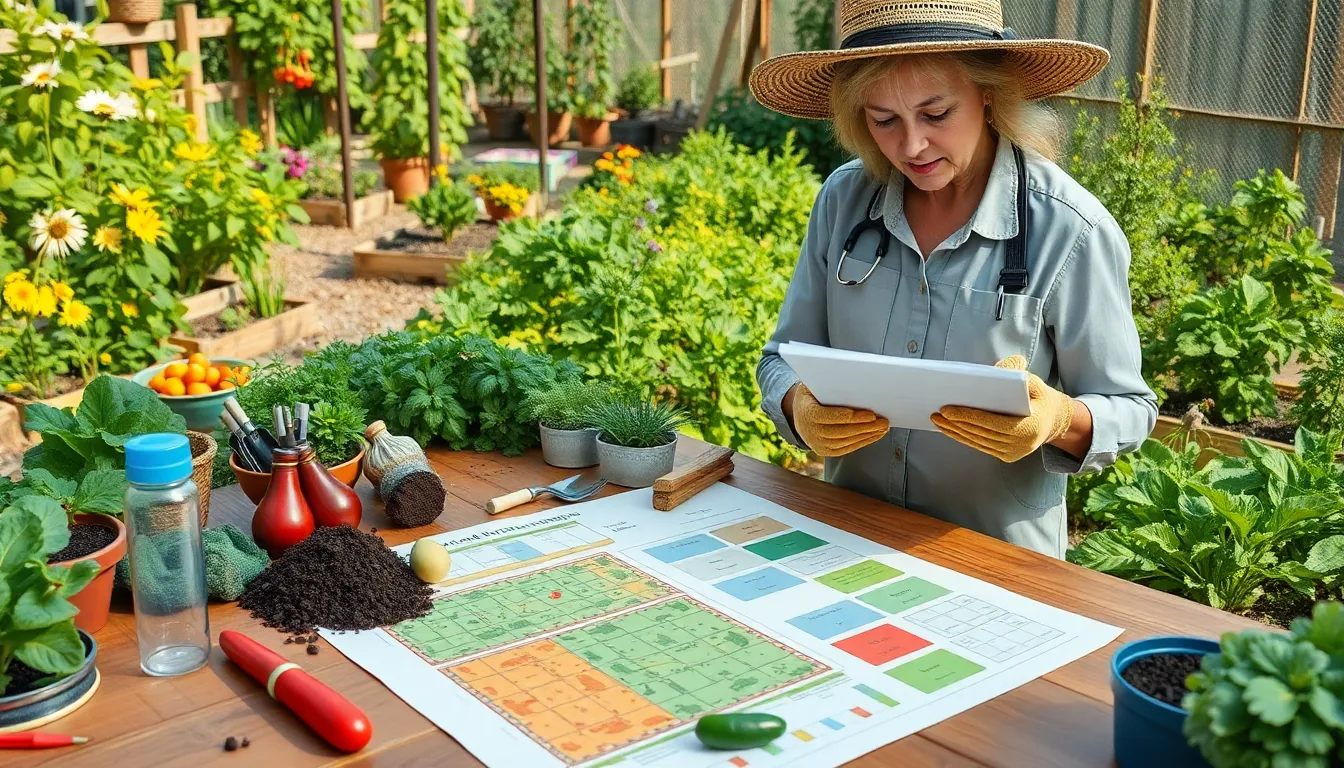
Visual mapping transforms our gardening approach by helping us visualize space usage and track plant performance over time. Research shows that gardeners who create detailed maps optimize their plant positioning for better sunlight exposure, water efficiency, and companion planting success.
Plot Layout Diagrams
Detailed plot diagrams capture the complete picture of our garden’s structure and organization. We should sketch the arrangement of plants, trellises, walkways, and hardscaping elements on paper or digitally, updating these diagrams seasonally to reflect crop changes and new plantings.
Including exact measurements for plant height, spread, and color helps us plan visually cohesive garden beds. These annotations serve as references for future seasons when we’re deciding plant placement and garden modifications.
Adding notes about infrastructure elements like raised beds, compost areas, and storage locations creates a comprehensive reference guide. This detailed documentation prevents spacing mistakes and helps us visualize how different garden elements work together functionally.
Crop Rotation Planning
Systematic crop rotation planning prevents soil depletion and reduces pest buildup in our garden beds. We need to track which crops were planted in each designated area by year, creating a historical record that guides future planting decisions.
Documenting plant families alongside their locations helps us avoid planting related crops in the same soil consecutively. For example, we should note when tomatoes, peppers, and eggplants occupied exact beds since they’re all nightshades that deplete similar nutrients.
Recording soil amendments and fertilizer applications for each bed creates valuable data about nutrient management. This information helps us understand which areas need exact treatments and when to apply them for optimal plant health.
Irrigation System Notes
Efficient water management requires detailed documentation of our irrigation setup and performance. We should map drip line placements, sprinkler coverage areas, and watering schedules to ensure consistent moisture delivery throughout our garden.
Tracking system adjustments and their results helps us optimize water usage over time. Notes about flow rates, timer settings, and coverage gaps provide actionable data for improving our irrigation efficiency.
Documenting seasonal water needs by garden zone creates a reference for future watering schedules. This information becomes especially valuable during drought conditions when we need to prioritize water allocation to our most productive areas.
Conclusion
We’ve explored how garden journals transform from simple notebooks into powerful tools that elevate our gardening success. By implementing these diverse tracking methods—from seasonal schedules and weather patterns to detailed plant profiles and harvest logs—we’re building a personalized gardening encyclopedia that grows more valuable each season.
The beauty of garden journaling lies in its flexibility. Whether we’re sketching garden layouts photographing plant progress or tracking expenses we’re creating a comprehensive resource customized to our unique growing conditions and goals.
Start small with just one or two tracking methods that resonate most with your gardening style. As these habits develop you’ll naturally want to expand your documentation. Remember that every entry—no matter how brief—contributes to a deeper understanding of your garden’s rhythms and needs.
Your garden journal becomes your most trusted advisor helping you make informed decisions that lead to more abundant harvests healthier plants and greater gardening satisfaction year after year.
Frequently Asked Questions
What is a gardening journal and why should I keep one?
A gardening journal is a detailed record of your gardening activities, observations, and experiences. It transforms casual gardening into a strategic practice by tracking planting schedules, plant performance, weather patterns, and pest issues. This documentation helps you make informed decisions, avoid past mistakes, and optimize your garden’s productivity year after year.
How do I start tracking seasonal planting schedules?
Begin by documenting your local frost dates and creating seasonal calendars. For spring, record soil conditions and germination rates. Summer tracking should focus on watering schedules and pest pressures. Fall documentation includes planting windows for cool-season crops and harvest preparation. Winter involves cleanup tasks and planning next year’s layout based on collected data.
What plant growth details should I record?
Document each plant’s journey from seed to maturity using growth charts on graph paper. Measure stem height and leaf count regularly, track flowering and fruiting timelines, and record environmental conditions alongside growth measurements. Include height and spread measurements to plan future garden spacing and companion planting arrangements effectively.
Why is weather documentation important for gardening?
Weather records transform your journal into a predictive tool. Track daily temperatures, rainfall amounts, and frost dates to understand how climate affects plant performance. Analyzing seasonal weather trends helps you adapt gardening strategies, improve plant placement based on microclimates, and build a comprehensive resource for future garden planning.
How should I document pest and disease issues?
Create a systematic approach by photographing pests and disease symptoms to build visual identification guides. Record treatment methods and their effectiveness to develop a personalized pest management toolkit. Document prevention strategies like proper plant spacing and beneficial insect introduction to reduce the need for reactive treatments.
What are plant profiles and how do I create them?
Plant profiles are detailed reference guides documenting variety performance, including yield data, pest resistance, and disease vulnerabilities. Record companion planting observations, noting successful plant combinations and their benefits. Monitor soil conditions to match plants with optimal growing environments and refine soil management strategies based on your observations.
How do I track harvest yields effectively?
Create weekly harvest logs recording quantities, dates, and quality indicators to identify peak production periods. Document storage methods and preservation techniques for your produce. Track recipe ideas that utilize fresh ingredients and connect garden yields to cooking practices to reduce food waste and improve meal planning.
What role does garden photography play in journaling?
Garden photography captures visual details that written observations might miss. Take before-and-after photos to track transformations, seasonal progress shots to document plant growth, and problem documentation photos for pest identification and disease symptoms. This visual reference library enhances your understanding of plant behavior and garden evolution.
Should I track gardening expenses in my journal?
Yes, detailed expense tracking is crucial for effective garden management. Record seed and plant purchases with dates, varieties, quantities, and costs. Track tool and supply investments, document maintenance schedules, and analyze cost per harvest to maximize return on investment and make informed future purchasing decisions.
How do I create effective garden maps?
Develop detailed plot layout diagrams capturing your garden’s structure, including plant arrangements and infrastructure elements. Plan systematic crop rotation to prevent soil depletion and reduce pest buildup. Include detailed irrigation system notes to optimize water management. These maps help visualize space usage and track plant performance over time.

